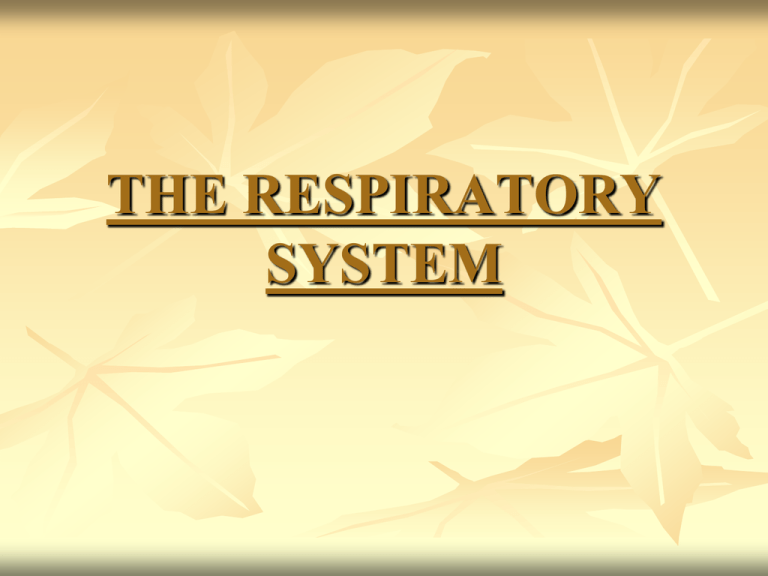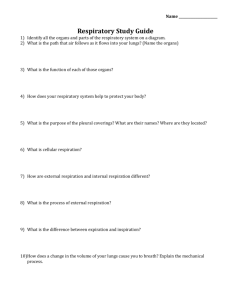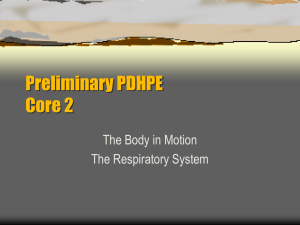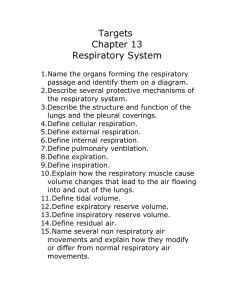the respiratory system
advertisement

THE RESPIRATORY SYSTEM THE HUMAN RESPIRATORY SYSTEM Organs of the Respiratory System 1. 2. 3. 4. 5. 6. 7. Nose Pharynx Larynx Trachea Bronchi Alveoli Lungs (Pleura) Function of the Respiratory System Oversees gas exchanges between the blood and external environment Exchange of gasses takes place within the lungs in the alveoli Passageways to the lungs purify, warm, and humidify the incoming air Organs of the Respiratory System Upper Respiratory System 1. The Nose The only externally visible part of the respiratory system Air enters the nose through the external nares (nostrils) The interior of the nose consists of a nasal cavity divided by a nasal septum Warms, moistens, and filters air 2. Pharynx Muscular passage from nasal cavity to larynx 3. Larynx Plays a role in speech (vocal cords) Vibrate with expelled air to create sound (speech) Glottis – opening between vocal cords 4. Epiglottis Spoon-shaped flap of elastic cartilage Superior opening of the larynx Routes food to the esophagus and air toward the trachea Action of the epiglottis 5. Trachea Connects larynx with bronchi Made of eight rigid hyaline cartilages Lined with ciliated mucosa Thyroid cartilage is the largest hyaline cartilage Protrudes anteriorly (Adam’s apple) Beat continuously in the opposite direction of incoming air Expel mucus loaded with dust and other debris away from lungs Walls are reinforced with C-shaped hyaline cartilage Upper Respiratory System The Lower Respiratory System 6. Bronchi Formed by division of the trachea Enters the lung at the hilus (medial depression) Right bronchus is wider, shorter, and straighter than left Bronchi subdivide into smaller and smaller branches 7. Bronchioles Smallest branches of the bronchi All but the smallest branches have reinforcing cartilage Terminal bronchioles end in alveoli The Lower Respiratory System 8. Alveoli Gas exchange takes place within the alveoli in the respiratory membrane Thin cellular layer lining alveolar walls Pulmonary capillaries cover external surfaces of alveoli 9. Lungs Occupy most of the thoracic cavity Apex is near the clavicle (superior portion) Base rests on the diaphragm (inferior portion) Each lung is divided into lobes by fissures Left lung – two lobes Right lung – three lobes The Lower Respiratory System 10. Pleura Pulmonary (visceral) pleura covers the lung surface Gas Exchange Gas crosses the respiratory membrane by diffusion Oxygen enters the blood Carbon dioxide enters the alveoli Complete the Lab Anatomy of the Respiratory System Events of Respiration Events of Respiration Pulmonary ventilation: air in and out of the lungs External respiration: gas exchange between the alveoli and the blood Transport: oxygen and carbon dioxide being transported to and from the body cells Internal respiration: gas exchange between the blood and the body cells Events of Respiration In more detail Pulmonary ventilation Moving air in and out of the lungs (breathing in and out) We will further explore this in the section “Mechanics of Breathing” External Respiration Exchange of gases between the alveoli of the lungs and the capillaries of the blood stream External Respiration Oxygen movement into the blood Carbon dioxide movement out of the blood The alveoli always has more oxygen than the blood Oxygen moves by diffusion towards the area of lower concentration Pulmonary capillary blood gains oxygen Blood returning from tissues has higher concentrations of carbon dioxide than air in the alveoli Pulmonary capillary blood gives up carbon dioxide Blood leaving the lungs is oxygen-rich and carbon dioxide-poor External Respiration Gas Transport in the Blood Oxygen transport in the blood Inside red blood cells attached to hemoglobin (oxyhemoglobin [HbO2]) A small amount is carried dissolved in the plasma Carbon dioxide transport in the blood Most is transported in the plasma as bicarbonate ion (HCO3–) A small amount is carried inside red blood cells on hemoglobin, but at different binding sites than those of oxygen Gas Transport in the Blood Internal Respiration Exchange of gases between the blood and body cells An opposite reaction to what occurs in the lungs (external respiration) Carbon dioxide diffuses out of tissue to blood Oxygen diffuses from blood into tissue Internal Respiration The Mechanics of Breathing (Pulmonary ventilation) see Figure 13.7 on pg 3 in your packet Completely mechanical process Depends on volume changes in the thoracic cavity Volume changes lead to pressure changes, which lead to the flow of gases to equalize pressure Two phases Inspiration – flow of air into lung Expiration – air leaving lung Inspiration Diaphragm and intercostal muscles contract The size of the thoracic cavity increases External air is pulled into the lungs due to an increase in intrapulmonary volume Expiration Largely a passive process which depends on natural lung elasticity As muscles relax, air is pushed out of the lungs Forced expiration can occur mostly by contracting internal intercostal muscles to depress the rib cage Pressure Differences in the Thoracic Cavity Normal pressure within the pleural space is always negative (intrapleural pressure) Differences in lung and pleural space pressures keep lungs from collapsing External Respiration, Gas Transport, and Internal Respiration Summary (page 5 in your packet) Non-respiratory Air Movements (not in your notes) Can be caused by reflexes or voluntary actions Examples Cough and sneeze – clears lungs of debris Laughing Crying Yawn Hiccup Respiratory Sounds (not in your notes) Sounds are monitored with a stethoscope Bronchial sounds – produced by air rushing through trachea and bronchi Vesicular breathing sounds – soft sounds of air filling alveoli Neural Regulation of Respiration (page 4 in your packet) Activity of respiratory muscles is transmitted to the brain by the phrenic and intercostal nerves Neural centers that control rate and depth are located in the medulla The pons appears to smooth out respiratory rate Normal respiratory rate (eupnea) is 12–15 respirations per minute Hypernia is increased respiratory rate often due to extra oxygen needs Factors Influencing Respiratory Rate and Depth Physical factors Increased body temperature Exercise Talking Coughing Volition (conscious control) Emotional factors Factors Influencing Respiratory Rate and Depth Chemical factors: Carbon dioxide levels Level of carbon dioxide in the blood is the main regulatory chemical for respiration Increased carbon dioxide increases respiration Changes in carbon dioxide act directly on the medulla oblongata Oxygen levels Changes in oxygen concentration in the blood are detected by chemoreceptors in the aorta and carotid artery Information is sent to the medulla oblongata Respiratory Rate Changes throughout Life Newborns – 40 to 80 respirations per minute Infants – 30 respirations per minute Age 5 – 25 respirations per minute Adults – 12 to 18 respirations per minute Rate often increases somewhat with old age Aging Effects Elasticity of lungs decreases Vital capacity decreases Blood oxygen levels decrease Stimulating effects of carbon dioxide decreases More risks of respiratory tract infection Developmental Aspects of the Respiratory System (not in your notes) Lungs are filled with fluid in the fetus Lungs are not fully inflated with air until two weeks after birth Surfactant that lowers alveolar surface tension is not present until late in fetal development and may not be present in premature babies Important birth defects Cystic fibrosis – over secretion of thick mucus clogs the respiratory system Cleft palate Complete the Lab Respiratory System Physiology Respiratory Vocabulary Eupnea = normal breathing rate Hypernea = abnormal breathing Dyspnea = difficult or labored breathing Apnea = cessation of (stopped) breathing Respiratory Volumes and Capacities (Page 3 in your packet) Tidal volume [TV] Normal breathing moves about 500 ml of air with each breath Many factors that affect respiratory capacity A person’s size Sex Age Physical condition Inspiratory reserve volume (IRV) Amount of air that can be taken in forcibly over the tidal volume Usually between 2100ml and 3200 ml Expiratory reserve volume (ERV) Amount of air that can be forcibly exhaled Approximately 1200 ml Residual volume Air remaining in lung after expiration About 1200 ml Vital capacity The total amount of exchangeable air Vital capacity = TV + IRV + ERV Dead space volume Air that remains in conducting zone and never reaches alveoli About 150 ml Respiratory Volumes and Capacities Complete the Lab Spirometry in Respiratory Function Respiratory Disorders Chronic Obstructive Pulmonary Disease (COPD) Exemplified by chronic bronchitis and emphysema Major causes of death and disability in the United States Features of these diseases Patients almost always have a history of smoking Labored breathing (dyspnea) becomes progressively more severe Coughing and frequent pulmonary infections are common Most victims retain carbon dioxide, are hypoxic and have respiratory acidosis Those infected will ultimately develop respiratory failure Emphysema Alveoli enlarge as adjacent chambers break through Chronic inflammation promotes lung fibrosis Airways collapse during expiration Patients use a large amount of energy to exhale Over inflation of the lungs leads to a permanently expanded barrel chest Cyanosis appears late in the disease An emphysema lung Chronic Bronchitis Mucosa of the lower respiratory passages becomes severely inflamed Mucus production increases Pooled mucus impairs ventilation and gas exchange Risk of lung infection increases Pneumonia is common Hypoxia and cyanosis occur early Chronic Bronchitis Lung Cancer Accounts for 1/3 of all cancer deaths in the United States Increased incidence associated with smoking Three common types Squamous cell carcinoma Adenocarcinoma Small cell carcinoma Lung Cancer Sudden Infant Death syndrome (SIDS) Apparently healthy infant stops breathing and dies during sleep Some cases are thought to be a problem of the neural respiratory control center One third of cases appear to be due to heart rhythm abnormalities Asthma Chronic inflamed hypersensitive bronchiole passages Response to irritants with dyspnea, coughing, and wheezing Treated with medications and inhalers Asthma Cystic Fibrosis Most common lethal genetic disease Thick mucus production causes problems with breathing and digestion Salty sweat (diagnosed with a sweat test) Cystic Fibrosis In people with cystic fibrosis, mucus in the airways is thicker than normal. The body also produces more mucus, and mucus tends to build up. The result is obstruction of airways—which makes breathing difficult—and the creation of an environment for infection-causing bacteria to grow. Pneumonia Infection in the lungs Caused by Bacteria (treatable with antibiotics) Virus fungus Pneumonia Whooping Cough Also called percussis Cough with a whooping sound Cough so hard that a person vomits, can’t catch his breath, or even turns blue Children are now immunized for this disease http://www.whoopingcough.net/symptoms.htm Tuberculosis Commonly called TB Caused by a bacteria that usually attacks the lungs – the bacteria will destroy tissue Spread from one person to another by air Skin test for the presence of the bacteria Tuberculosis Latent TB – persons who have the bacteria but do not get sick (they do not spread it, but they may become sick later) Active TB - symptoms include Bad cough lasting 3 weeks or longer Pain in chest Coughing up blood Weakness or fatigue Loss of appetite – weight loss Chills and fever Night sweats








